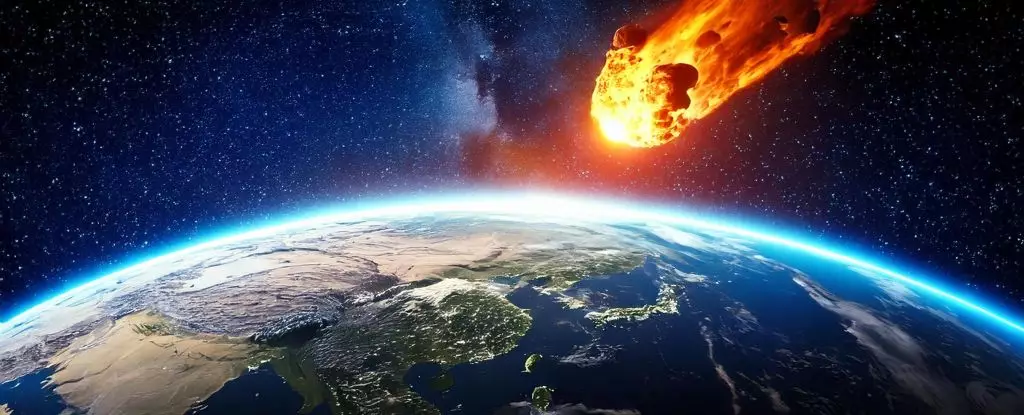Earth has long been a target for celestial bodies, drifting in the vast expanse of our solar system. While many of us may feel safe from such threats today, recent simulations have highlighted the potential consequences of a significant asteroid impact, particularly from the infamous asteroid Bennu. Over the next century, our planet could face an impact from this hill-sized space rock, raising profound questions about humanity’s preparedness for such a catastrophic event. The last time a large asteroid struck Earth was 66 million years ago, famously associated with the demise of the dinosaurs. However, as we continue to explore the cosmos, we face the stark reality that large asteroids are still a threat, potentially poised to change life on Earth once again.
Bennu, with an estimated diameter of 500 meters (1,640 feet), may seem comparatively small next to the asteroid that led to the extinction of the dinosaurs, which was between 10 to 15 kilometers in size. Despite its smaller stature, the impending threat of Bennu is not negligible. The probability of its collision with Earth in September 2182 CE stands at just 1 in 2,700, or roughly 0.04 percent. While this may sound reassuringly low, it is important to remember that even a small chance can result in devastating consequences. To understand what such an event could entail, scientists have utilized advanced computer simulations to forecast the aftermath of a Bennu collision.
Researchers from South Korea’s Pusan National University conducted extensive simulations using the Aleph supercomputer, examining the potential environmental impacts of Bennu striking Earth. Their findings were alarming: an impact would result in the injection of approximately 100 to 400 million tons of dust into the stratosphere. This would lead to severe disruptions in climate patterns, atmospheric chemistry, and global photosynthesis—crucial processes for life on Earth. The projected global temperature drop of 4 degrees Celsius could result in significant declines in precipitation, decreasing by as much as 15 percent.
Dai and Timmerman, the lead researchers on the study, emphasized that it’s not just the immediate impact that threatens our survival, but the lasting changes that would ensue. Their models predict that ozone depletion would reach 32 percent, exposing terrestrial and marine ecosystems to harmful UV radiation. Fossil records and geological data indicate that the lasting effects of such impacts have historically led to substantial disruptions in global food systems.
One of the most concerning predictions from the simulation is the drastic reduction in photosynthesis, projected to drop by 20 to 30 percent initially. Given that more than half of Earth’s ecosystems depend on healthy plant life, such a decline could threaten the foundation of our food systems, leading to widespread food insecurity. Climate challenges would compound these issues, making recovery a daunting task.
However, it is essential to address the broader ecological picture that emerges from these simulations. While terrestrial plants are highly susceptible to the adverse conditions created by an impact winter, marine algae, particularly diatoms, show a remarkable resilience. These microscopic organisms could rebound quickly, potentially flourishing in the nutrient-rich asteroid dust. This suggests that, while terrestrial ecosystems may struggle, marine ecosystems could provide a crucial lifeline, supporting food chains and helping to mitigate some of the disaster’s worst impacts.
Looking forward, understanding the asteroid threat requires a broader perspective on humanity’s resilience. Statistically, medium-sized asteroids are estimated to collide with Earth every 100 to 200 thousand years, implying that while we may not frequently face colossal impacts, these occurrences are far from rare across an evolutionary timeline. Early human ancestors likely endured their share of planetary upheavals that altered environmental conditions and possibly even influenced genetic evolution.
Although the potential for human survival after an impact event—including one from Bennu—exists, it raises crucial questions about our lifestyle and adaptability in the face of such challenges. Would humanity endure as we know it today, or would survival necessitate radical lifestyle changes? Furthermore, how might society respond to an ecological collapse brought about by an asteroid impact?
While the prospect of an asteroid collision paints a grim picture of our future, it is also an opportunity for humanity to reflect on its resilience and adaptability. The journey towards preparedness must begin with awareness and research, understanding that cosmic threats can—and likely will—impact life on Earth at some point. By bolstering our scientific understanding and fostering global cooperation, we can better prepare ourselves for the ultimate test from the cosmos, ensuring the survival of humanity, even in the wake of disaster. Thus, as humankind gazes upon the stars, we must also remember to safeguard our planet until the day we can deflect the next cosmic menace.

